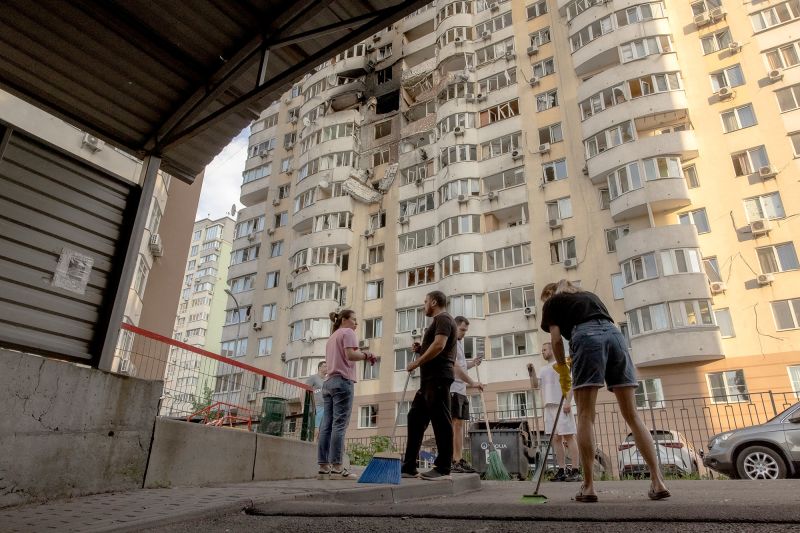
On a recent evening in Kyiv, 4-year-old Olexander Reshetnik made a simple suggestion to his parents: “Let’s go to the parking garage now so we can sleep properly, and you don’t have to wake us up twice to take us there and back.”
The family lives on the 18th floor of a high-rise building and getting into the underground garage that doubles as a bomb shelter during Russian attacks is an uncomfortable experience. With aerial attacks becoming more common, it made sense to Oleksander to simply stay there.
Even at his young age, he knew the Russians would likely attack again.
His mother Khrystyna Reshetnik said the family has gotten used to seeing drones being shot down in the skies over Ukraine’s capital. In days gone by there would be one or two, maybe three, but things have changed.
Russia has ramped up its airborne attacks against Ukraine in recent weeks, launching as many as 479 drones and missiles in a single night. These assaults are not just bigger and more frequent; they are also more concentrated and executed in a way that makes them a lot more difficult to combat – as they are flown at higher altitudes, out of reach of machine guns.
Russia ramps up drone production
Russia successfully scaled up the domestic production of its most frequently used drone – the Iranian-designed Shahed – last fall and is now churning out hundreds of these killing machines every day.
Christina Harward, a Russia analyst at the Institute for the Study of War, said that according to current estimates, Moscow can now produce about 2,700 Shahed drones per month, as well as some 2,500 decoy drones.
The fact that some of the drones are decoys makes little difference to the Ukrainian defenses as Moscow has adapted them in a way that makes it very difficult to distinguish them from the real thing.
“So, either Ukrainian forces spend time trying to identify the decoys or they spend precious resources shooting them down. Either way, this helps the Russian missiles and Shaheds – with their large payloads – (as they) have the chance to get through to their targets,” Harward said.
The increased number of drones launched each night is overwhelming Ukrainian air defenses, especially since Russia began to zero in on handful of locations at a time.
On Monday night, it targeted the Ukrainian capital and the Black Sea port city of Odesa. The following night, it was Kharkiv, Ukraine’s second-largest city.
Russia maintains that it does not target civilians, but evidence to the contrary continues to mount. At least 154 Ukrainian civilians – including children – have been killed by drones, in Russian missile assaults and by artillery across the country in the last four weeks. A further 900 civilians have been injured.
The deadly attacks are designed to undermine Ukrainian morale and create the illusion that Russia has the upper hand in the war – even though Moscow is far from “winning.”
The front line in Ukraine has not moved in any significant way since Ukrainian forces liberated the southern city of Kherson in November 2023.
Russia has only managed to seize about 5,000 square kilometers (1,900 square miles) of Ukraine’s territory since then. Russian troops have advanced in some areas in eastern and northern Ukraine in recent months but have not managed to break through or take over a major city.
‘Impossible to shoot them down’
Yuriy Chumak spends many of his nights perched on Kyiv’s rooftops, machine gun in hand. A Supreme Court judge by day, he is part of a volunteer drone-hunting unit by night. He said the skies have gotten significantly busier in recent weeks.
He said after Moscow started flying drones at higher altitudes, it has become much harder, if not impossible, for his unit to destroy them.
Previously, Russian forces would fly the drones low, for example along a riverbed, to avoid being detected by Ukraine’s air defenses for as long as possible.
“The time to respond was very short because we only detected it when it was (close),” he said.
These days, he said, Russian drones are flying two to five kilometers (1 to 3 miles) above the ground.
“We can see them all. Radars can track them. But it has become impossible to shoot them down with machine guns,” Chumak said, adding that Ukraine now has to use missiles to thwart them.
But missiles are in much shorter supply. This is pushing Ukrainian forces to find new solutions on the go. Melnyk said that the efficiency of Ukraine’s air defense system remains remarkable. “Even now, about 80% of drones are being intercepted. A few months ago, this percentage was about 95. (But) we can see the impact of Russia increasing the number (of drones) and changing tactics,” he added.
Speaking to reporters last month, Ukraine’s President Volodymyr Zelensky praised the Ukrainian Air Force and volunteers like Chumak for pivoting as Russia ramped up its air war.
He added that Kyiv was now using drone-to-drone interceptors to combat the higher altitude bombardment. “We have the technology. The question is when we will be able to expand,” he said.
Zelensky said that Russia can produce some 300 to 350 drones a day, while Ukraine can only make 100.
“The issue is no longer about production capacity. It’s financial,” he said.
‘The norm for our children’
Kyiv mom Khrystyna Reshetnik said one of the worst things about the Russian aerial assaults is that they have become commonplace to her three boys, aged 4, 8 and 11. Olexander regularly asks whether the noise he hears is a Kalibr cruise missile or a drone.
“He’s just a little boy and he already understands what’s going on,” Reshetnik said. As the attacks have intensified in size and scope, the family has been spending more time in the underground parking garage, where Olexander and his two brothers sleep in the trunk of their car.
“This has become the norm for our children. It hurts my heart,” she said.

Yet despite the daily horrors they experience, the Reshetniks are among the lucky ones. They live in Kyiv, a city that is relatively well defended. The majority of the explosions they hear are Ukrainian air defenses intercepting Russian drones.
Many others elsewhere around the country are left without protective shields because Ukraine’s access to air defenses is limited by what its Western allies are willing to spare. Closer to the front lines, Russian troops have been using smaller drones to target civilians.
“There is (a) ballistic missile coming, so I am going to go into the shelter. My point is that this is the daily life of Ukrainian citizens and civilians.”

